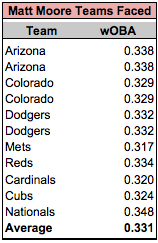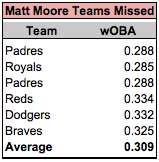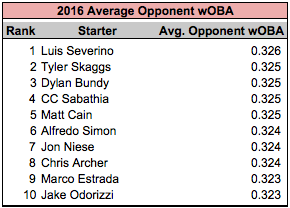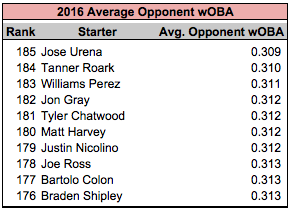Detroit’s Batted-Ball Readings Are Hot
Editors Note: Analysis in this article was conducted using Baseball Info Solutions Hard Hit batted ball data.
To be clear, this did not begin as an example of investigative journalism. While I do occasionally enjoy media pieces such as Spotlight and S-Town, my curiosity in this topic all began with the incredible amount of attention given to a seemingly mediocre player named Nick Castellanos. To give some examples, below are three popular FanGraphs/RotoGraphs articles written about Castellanos:
- Nick Castellanos: The Greek God of Hard Contact (Rylan Edwards – March 30, 2017)
- Turning Nick Castellanos Into Nolan Arenado (Jim Melichar – March 4, 2017)
- The Wait for Nick Castellanos Will Soon Be Over (Eno Sarris – November 4, 2015)
In theory, the hype surrounding Nick Castellanos makes sense. High hard-hit rate, few ground balls, sustainable HR/FB%, and a decent home ballpark. If only he could get those strikeouts down and avoid bad luck, he could turn into Kris Bryant or Nolan Arenado. The analytics community, who have been waiting for the Castellanos breakout for five years, is more divided than ever on the Tigers third baseman. Some continue to beat the drum while others are abandoning ship, arguing that the breakthrough will never happen.
This season, Castellanos is not the only Detroit Tigers player who has received love from the analytics community:
- Alex Avila: The Tigers Have Found Another Slugger (Dave Cameron – May 22, 2017)
- Miguel Cabrera: How to Beat Statcast’s Hitting Metric (Craig Edwards – May 16, 2017)
The claims brought up by all of these writers have one thing in common: high or increased hard-hit rate. As presented in Matthew Ludwig’s article The Value of Hitting the Ball Hard, hard-hit rate and wRC+ have a positive correlation. In general, a player who hits the ball harder would be expected to have more favorable results when they make contact.
This brings us to the question, is it possible for so many Detroit Tigers players to be underperforming their batted-ball profiles? In order to gauge exactly how much harder the Tigers are hitting the ball than their opponents this year, I took a look at the hard-hit rate for the Tigers as a team. The point that is colored “Tiger orange” represents the Detroit Tigers.

It isn’t even close; the 2017 Detroit Tigers are currently the best team at making hard contact and the worst team at preventing hard contact. Thinking qualitatively, are the Tigers hitters really that much better at making hard contact than the hitters on the Astros, Nationals, or Diamondbacks? Are the pitchers really that much worse at preventing hard contact than the pitching on the Padres, Orioles, or Reds? If so, the results are not proving it. The Tigers currently rank ninth in runs scored and 20th in runs against. Park factors and other variables do apply, so it may be possible that the hitters are getting unluckier and the pitchers are getting luckier than the batted-ball data shows. Assuming that players’ abilities are transferable across stadiums, we should small differences in hard-hit rate for Tigers hitters and pitchers when looking at home/away splits.

Quadrant I (x,y) represents the teams that have a higher hard-hit rate for both hitters and pitchers on the road than at home. Quadrant III (-x,-y) represents the teams that have a higher hard-hit rate for both hitters and pitchers at home than on the road. The Detroit Tigers (orange point) rank as the team with the largest negative difference for both hitters and pitchers. One thing to note about the data is that 22 out of the 30 points lie within either quadrant I or quadrant III. This could give some validity to the assumption that hard-hit rate is not consistently measured from park to park. There could be a variety of reasons for this (humidity, air density, etc.). For more on this, I would point to Andrew Perpetua’s article Home And Road Exit Velocity. If there was truly something unique about Detroit causing these balls to be measured harder, this trend would be seen over a wider time period. Let’s look at where the Tigers ranked for the years 2012-2016.

See that orange circle almost directly in the middle of the chart? That is the Detroit Tigers. The only point that has a closer distance to the direct center is the Atlanta Braves, who now play in an entirely different city and stadium.
So what about all other stadiums? If hard-hit rate is being artificially increased at Comerica Park, it is likely that there are slight adjustments at all ballparks. Based on 2017 data, the difference for each stadium (hitters or pitchers) is listed below:

Looking at an individual-player level (min. 50 AB home and away, min. 20 IP home and away), let’s see how many Tigers batters appear on the top 20 away-home hard-hit-rate difference leaderboard for hitters and pitchers. Detroit Tigers players are highlighted in orange.


I can see four possible scenarios to explain why Detroit Tigers players may be experiencing this phenomenon:
- Tigers hitters and pitchers have actually experienced large splits between home/away hard-hit rate this year (with no other variables changing)
- Something about Comerica Park is causing increased error in the variables used for the quality of contact algorithm
- Changes are being made to the ball or environment at Comerica Park, making it act differently
- Small sample size bias is skewing the data
Unfortunately, this is about as far as I can take this piece. Something is going on in Detroit this year that is skewing the hard-hit-rate calculations. However, the whys and hows beyond the data are not clearly evident. Until then, I will continue to monitor this unintended project of investigative journalism from the sidelines.





